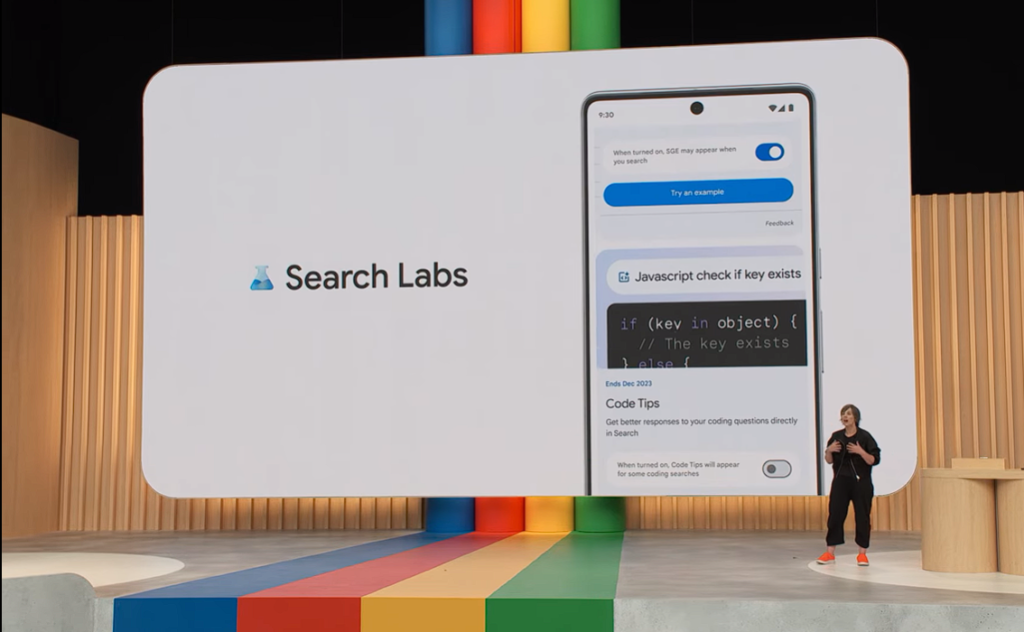
Can Google’s New AI-Powered Search Strike the Right Balance of Content and Ads?
Google has unveiled its new Search Generative Experience (SGE), set to drop AI-generated answers above traditional search results. The goal is to streamline the experience in a way that allows users to find results faster, delve deeper, achieve things faster — but will an inundation of ads kill the buzz?
A bombshell was announced at the Google I/O 2023 Keynote Event: the secretive “Magi” project is now Search Generative Experience (SGE). It represents a giant leap toward full generative AI in Google Search, hot on the heels of Microsoft’s “New” Bing.
SGE is open for early access through Search Labs portal — itself a new offering from the tech giant. Google Search Labs allows users the opportunity to explore and test experimental AI features within Google Search, offering a firsthand experience with the latest online technologies.
During the I/O Keynote, Google’s Vice President of Search Discovery & Ecosystems, Cathy Edwards, conducted a live demonstration to showcase the introduction of generative AI into Google Search. She queries: “Good bike for a 5 mile commute with hills.” Sure enough, a section expands with a number of apt factors to consider when making this purchase. The generated answer is clearly labelled as experimental.
With live information from the web, Google is providing users with relevant and informative responses to enhance their search experience. A summary of links to the external sites that supported the information is provided. Results are displayed in a shaded section below the search bar and sponsored results above the regular SERP.
At the top right, there’s a button that allows you to expand the snapshot, revealing additional cards with sourced articles. If you have follow-up questions, you can simply tap a button below the results to continue the conversation.
Unlike Bing, Google’s AI search integrates seamlessly with the familiar input bar rather than opening a separate chatbot field. Bing Chat and SGE differ somewhat in user experience, but both make use of large language models (LLMs) in a similar way. The generated text is supplementary rather than replacing existing search index results entirely.
There’s a little opt-in box at the top of search results. A minor addition, but billions of users will soon be reassessing and reimagining how to find information online.
With new breakthroughs in generative AI, we’re again reimagining what a search engine can do. With this powerful new technology, we can unlock entirely new types of questions you never thought Search could answer, and transform the way information is organized, to help you sort through and make sense of what’s out there … You’ll see an AI-powered snapshot of key information to consider, with links to dig deeper.
Elizabeth Reid
Vice President & GM, Search
https://blog.google/products/search/generative-ai-search/
Access to SGE is currently limited to a finite number of US users. The slow roll-out is unsurprising: while Google has invested heavily in AI for many years, there have always been fears over what AI could mean for the company’s bottom line.
For Google to ensure the success of its AI-powered search, it will need to find effective ways to monetize this technology. The long-term viability depends on Google’s ability to generate revenue from these innovations.
A notable aspect of SGE is its capability to provide specific details when inquiring about a particular feature of a product. Users can expect to receive precise information along with reviews and recommendations for the best purchasing options. This feature enhances the search experience by streamlining the process of gathering relevant product details, allowing users to make informed decisions.
Google plans to enhance its Automated Creative Assembly (ACA) with the power of AI to enable the creation of customised Search ads to better match the context of a user’s query. For example, when someone searches for “plants for a dark dorm room,” AI can utilise content from a company’s landing page and existing ads to generate a new headline that aligns even more closely with the search query.

A significant concern surrounding SGE is the potential for ads to become more intrusive within the search interface. There is a worry that ads might dominate the search experience, making it challenging to distinguish between sponsored content and genuine search results.
Sponsored ads are clearly identified with dedicated positions and slots. Striking the right balance will be a difficult balancing act for Google. Specifically, how will they strike the balance between AI and Pay For Click advertising? If the distinction blurs too substantially, there is a risk the feature will lose its appeal.
Some may choose to forgo the middle man and opt for AI services on subscriptions, ad-free. OpenAI continues to offer a paid subscription plan, ChatGPT Plus, released back in February and around $20 per month. OpenAI also offers subscription-based APIs for organisations wishing to take advantage of the model for their specific needs. Last month, Forbes suggested ChatGPT could eventually add $40b to Microsoft’s top line.
During the initial phase of the new search experience, advertisers will not have the immediate option to opt out of displaying ads. Google will closely monitor the performance of ad placements and experiences throughout this experimental period.
Without proper oversight, AI algorithms may prioritise aggressive targeting or bombard users with excessive ads, leading to a disruptive and overwhelming online advertising experience.
As Google continues to develop and refine AI-powered search capabilities like SGE, it becomes crucial for the company to strike a balance between delivering value to users and finding effective monetisation strategies. By doing so, Google can sustain the innovation and quality of its AI-driven search while providing a revenue stream that supports further development and improvements.
To get on the waitlist for Search Generative Experience, visit the Search Labs homepage and sign in to your personal Google account. From there, click the Join waitlist button, and you will receive an email notification from Google once you gain access to Search Labs.
